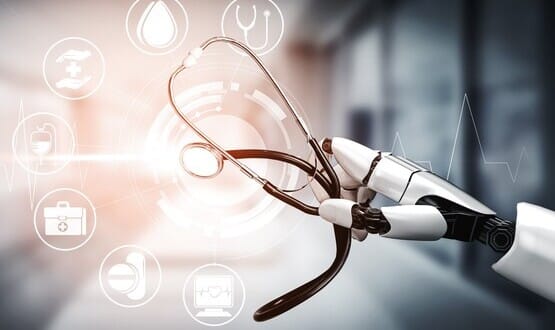Addressing a burning issue
- 29 October 2013

There are plenty of medical and healthcare apps out there. So what made the Mersey Burns App stand out to the point where it won not just ‘excellence in mobile healthcare’ at the EHI Awards 2013 in association with CGI, but also ‘overall winner’?
Certainly, it addresses a real issue in healthcare – helping to improve the assessment and resuscitation of seriously burned adults and children.
Certainly, it is a slick application, making full use of touch screen technology. Certainly, reviewers rate it highly, with four and a half stars on the iTunes App Store.
More than this, though, it is the work by the developers to embed it into clinical practice through testing, research and regulation.
The Mersey Burns App is the first UK healthcare app to carry a CE mark from the Medicines and Healthcare Products Regulatory Agency, setting a gold standard for healthcare app innovation, evaluation and implementation. BAPRAS, the plastic surgeons professional association, has endorsed it.
And if the developers – Rowan Pritchard-Jones, consultant plastic surgeon at St Helens and Knowsley NHS Trust, his boss Professor Paul McArthur, and PhD student Chris Seaton – have their way, it will become the default option and replace paper policies.
Doing away with paper and maths
The Mersey Burns App, as Pritchard-Jones explains, addresses a well-known issue. When a patient with severe burns arrives in A&E, the receiving doctor quickly assesses the extent of the burn to calculate how much fluid to give to the patient.
“If you can get that right in the first hour, you can save lives,” he says. “Too little fluid and the burn can go deeper, leading to more surgery. Too much and you can put the patient into heart failure.”
The calculation is not a one-step sum, however. “There are 19 calculations that need to be done, all with the patient lying on the resus bed, before you can start their fluid pump.”
Most A&E doctors will see one or two major burns a year and will use paper, pen and a written protocol to make these calculations. Seaton, a former medical support officer with the Royal Army Medical Corps, recalls seeing doctors in army field hospitals write the result of calculations in marker pen on a patient’s chest to avoid the details being lost.
The Mersey Burns App makes all this easier. On a touch screen, the doctor can shade the area of the patient covered by the burn, add the patient’s weight, their age if they are a child, and the time of injury. The app does the rest.
This “rest” includes not only telling the doctor how much fluid the patient needs, but formatting the details of the injury into an email, encrypting it and sending it on to the regional burns unit that will receive the patient after being stabilised.
“That means we know what’s coming and we can get the right theatre teams and so on in place,” says Pritchard-Jones.
Tested and tested again
The Mersey Burns App has been rigorously tested, first with A&E doctors and plastic surgeons and then with medical students just about to graduate, who tested the app in simulation wards.
This was an important study – one that is just about to be published – because the students had no preconceptions about paper versus apps. They were taught how to use both methods simultaneously before using them in the test environment.
The Mersey Burns App enabled students to arrive at the correct fluid calculation 15 minutes earlier than if they were using paper, on average. “That’s pretty significant within that golden hour,” says Pritchard-Jones. They liked it and they trusted it.
That is not a blind trust, either, as the safety testing has been extensive. “This was all part of the journey with the MHRA,” says Pritchard-Jones. “When we were first developing this idea, one of the major worries was indemnity. What happens if someone uses this and the patient dies?”
He worked with the trust to develop a model in which the trust provides indemnity in exchange for the intellectual property rights to the app.
The app is now available for iPad and iPhone as well as Android platforms and HTML 5. To date, more than 7,000 people have downloaded it.
Working on a deployment strategy
Over the past year, the developers have been working on a deployment strategy, supported by a Health Innovation and Education Cluster grant and an NHS Innovation Award.
“We are getting it into A&E units across the city and we are doing audit work to see how much they are using it,” says Pritchard-Jones. “Alder Hey [children’s hospital] is using it on iPad and are now scanning the patient’s bar code so results can be added automatically into the electronic record.”
In the NHS, the app will be used by doctors. Seaton says that in the army it may be used by non-medics including army combat medics – soldiers trained in advanced first aid.
“I started writing this when I was in the army. I had seen some very young soldiers, people with very little educational background, being asked to do some extraordinary things in applying first aid,” he says.
Part of its appeal is that it looks and feels like a professional iPhone app, he adds. “There are a lot of medical apps out there and a lot of them look cheap and simplistic,” he says. “We wanted this to look professional and I am proud of taking it to the professional level.”
He argues that it could replace the paper policy. “There is no difference between saying ‘this paper is the policy’ and saying ‘this app is the policy’,” he says. “It just takes away the need for doctors to do complicated maths in their heads.”
Having said that, Pritchard-Jones recognises that developing an app, testing it, building in the safety and building it into workflows is one thing; getting it widely adopted is quite another.
“That’s why awards like this are so important,” he says. “Along with the publications and the accreditations, it all helps to spread the word.” The word that there is a faster, more accurate and safer way of working and that it can save people’s lives.
The developers behind the Mersey Burns App will be at EHI Live 2013. They will be part of HANDI Health Apps, a new conference steam that will discuss hot topics in healthcare apps, including quality and regulation, show off some of the latest apps, and let visitors try building an app of their own.
EHI Live 2013 is more than a meeting, more than an exhibition. For anyone involved in the use of information in healthcare it’s a golden opportunity to update knowledge, get answers to questions, meet the experts and think about the future. This year’s conference is free for all visitors to attend.




